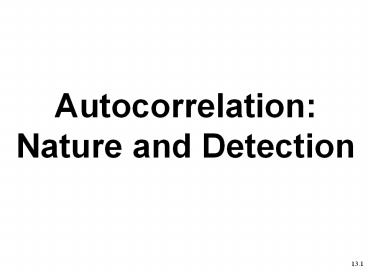Autocorrelation: - PowerPoint PPT Presentation
Title:
Autocorrelation:
Description:
Autocorrelation: Nature and Detection Aims and Learning Objectives By the end of this session students should be able to: Explain the nature of autocorrelation ... – PowerPoint PPT presentation
Number of Views:548
Avg rating:3.0/5.0
Title: Autocorrelation:
1
Autocorrelation Nature and Detection
2
Aims and Learning Objectives
- By the end of this session students should be
able to - Explain the nature of autocorrelation
- Understand the causes and consequences of
- autocorrelation
- Perform tests to determine whether a regression
- model has autocorrelated disturbances
3
Nature of Autocorrelation
Autocorrelation is a systematic pattern in the
errors that can be either attracting (positive)
or repelling (negative) autocorrelation. For
efficiency (accurate estimation/prediction) all
systematic information needs to be incor-porated
into the regression model.
4
Regression Model
Yt ?1 ?2X2t ?3X3t Ut
Cov (Ui, Uj) or E(Ui, Uj) 0
No autocorrelation
Autocorrelation
Cov (Ui, Uj) ? 0 or E(Ui, Uj) ? 0
Note i ? j
In general
E(Ut, Ut-s) ? 0
5
Ut
Attracting
.
.
.
.
.
.
.
Postive Auto.
.
.
.
.
.
.
.
0
.
.
.
.
.
.
.
.
t
Ut
Random
.
.
.
.
.
.
.
.
.
.
.
.
No Auto.
.
.
.
.
.
.
.
.
.
0
.
.
.
.
.
.
t
.
.
Repelling
.
Ut
.
.
.
.
.
.
.
Negative Auto.
.
.
0
.
.
.
.
.
t
.
.
6
Order of Autocorrelation
Yt ?1 ?2X2t ?3X3t Ut
Ut ??Ut?1 ?t
1st Order
Ut ?1?Ut?1 ?2?Ut?2 ?t
2nd Order
Ut ?1?Ut?1 ?2?Ut?2 ?3?Ut?3 ?t
3rd Order
Where -1 lt ? lt 1
We will assume First Order Autocorrelation
Ut ??Ut?1 ?t
AR(1)
7
Causes of Autocorrelation
- Indirect
- Omitted Variables
- Functional form
- Seasonality
- Direct
- Inertia or persistence
- Spatial correlation
- Cyclical Influences
8
Consequences of Autocorrelation
1. Ordinary least squares still linear and
unbiased. 2. Ordinary least squares not
efficient. 3. Usual formulas give incorrect
standard errors for least squares. 4.
Confidence intervals and hypothesis tests based
on usual standard errors are wrong.
9
Yt ?1 ?2Xt et
E(et, et-s) ? 0
Autocorrelated disturbances
Formula for ordinary least squares variance (no
autocorrelation in disturbances)
Formula for ordinary least squares
variance (autocorrelated disturbances)
Therefore when errors are autocorrelated
ordinary least squares estimators are inefficient
(i.e. not best)
10
Detecting Autocorrelation
et provide proxies for Ut
Preliminary Analysis (Informal Tests)
- Data - autocorrelation often occurs in
time-series - (exceptions spatial correlation, panel data)
- Graphical examination of residuals - plot et
against - time or et-1 to see if there is a relation
11
Formal Tests for Autocorrelation
Runs Test analyse the uninterrupted sequence of
the residuals
Durbin-Watson (DW) d test ratio of the sum of
squared differences in successive residuals to
the residual sum of squares
Breusch-Godfrey LM test A more general test
which does not assume the disturbances are
AR(1).
12
Durbin-Watson d Test
The Durbin-Watson Test statistic, d, is
Ratio of the sum of squared differences in
successive residuals to the residual sum of
squares
13
(No Transcript)
14
DW d Test
4 Steps
Step 1 Estimate
And obtain the residuals
Step 2 Compute the DW d test statistic
Step 3 Obtain dL and dU the lower and upper
points from the Durbin-Watson tables
15
Step 4 Implement the following decision rule
16
- Restrictive Assumptions
- There is an intercept in the model
- X values are non-stochastic
- Disturbances are AR(1)
- Model does not include a lagged dependent
- variable as an explanatory variable, e.g.
Yt ?1 ?2X2t ?3X3t ?4Yt-1 Ut
17
Breusch-Godfrey LM Test
This test is valid with lagged dependent
variables and can be used to test for higher
order autocorrelation
Suppose, for example, that we estimate
Yt ?1 ?2X2t ?3X3t ?4Yt-1 Ut
And wish to test for autocorrelation of the form
18
Breusch-Godfrey LM Test
4 steps
Step 1. Estimate Yt ?1 ?2X2t ?3X3t
?4Yt-1 Ut obtain the residuals (et) Step 2.
Estimate the following auxiliary regression
model
19
Breusch-Godfrey LM Test
Step 3. For large sample sizes, the test
statistic is
Step 4. If the test statistic exceeds the
critical chi-square value we can reject the null
hypothesis of no serial correlation in any of
the ? terms
20
Summary
In this lecture we have 1. Analysed the
theoretical causes and consequences of
autocorrelation 2. Described a number of
methods for detecting the presence of
autocorrelation

